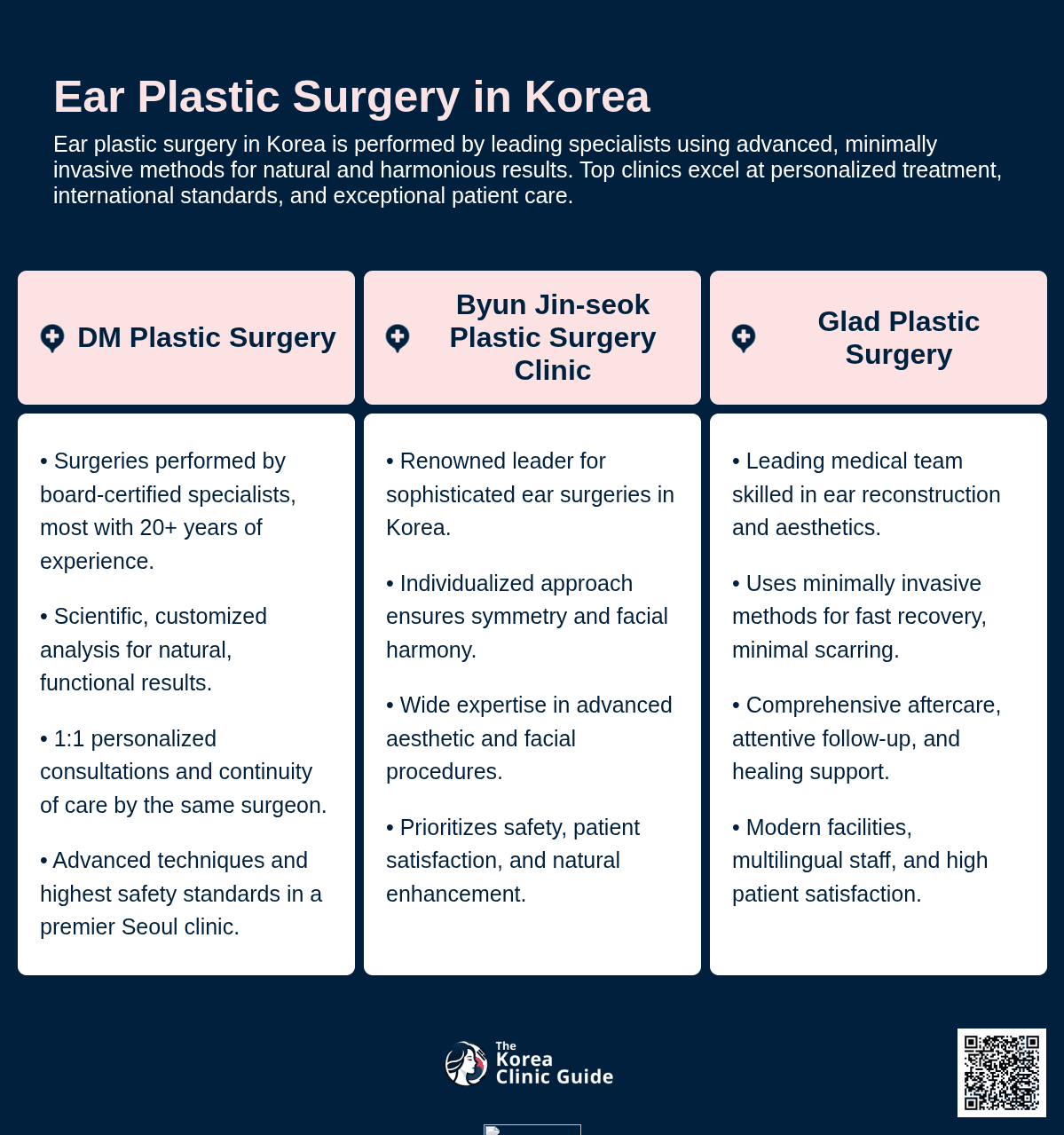Medical Tourism Blog
Ear Plastic Surgery in Korea | Best Clinics, Costs, Procedure Types & More

Table of contents
- What Is Ear Plastic Surgery?
- Best Clinics in Korea for Ear Plastic Surgery
- Ear Plastic Surgery in Korea
- Cost of Ear Plastic Surgery in Korea
- Alternatives to Ear Plastic Surgery
- Conclusion
Considering treatment in Korea? Everything you need to know e.g. — how to avoid scams, visas, interpreters, recovery tips — in our Medical Tourism Master Guide. Plan with confidence in minutes, not weeks!
Have you ever wondered why South Korea is a prime destination for ear plastic surgery? With its world-class healthcare system and pioneering cosmetic techniques, Korea has become the go-to place for individuals seeking to enhance or correct their ear aesthetics. This article explores the intricacies of otoplasty, the reasons behind Korea's leading reputation in this field, and the costs and alternatives associated with this transformative procedure.
What Is Ear Plastic Surgery?
Ear plastic surgery, also known as otoplasty, is a specialized surgical procedure aimed at altering the shape, size, or position of the ears. It is often performed for both cosmetic and medical reasons, whether for adults seeking aesthetic adjustments or children needing corrective surgery due to congenital conditions. Otoplasty is particularly popular in South Korea, a country renowned for its advanced and innovative approaches to cosmetic surgery.
Who is Ear Plastic Surgery For?
Ear plastic surgery is suitable for a variety of individuals:
-
Children: A significant number of otoplasty procedures are performed on children, often as young as five years old. As the ears reach their full size by this age, early intervention can help correct congenital deformities and prevent potential psychological stress over ear appearance during childhood.
-
Adults: Many adults elect to undergo ear plastic surgery due to dissatisfaction with the size, shape, or prominence of their ears. Some adults also seek otoplasty to repair damage from injuries or to correct issues from previous surgeries.
-
Medical Cases: Patients with congenital ear deformities, such as microtia (underdeveloped ears) or anotia (absence of one or both ears), can benefit from reconstructive surgeries tailored to improve or create a more typical ear structure.
Types of Ear Plastic Surgery Procedures
Ear plastic surgery encompasses several types of procedures, each catering to different aesthetic and functional needs:
-
Ear Pinning (Setback Otoplasty): This is one of the most common otoplasty procedures. It involves repositioning the ears closer to the head to reduce their prominence. Surgeons achieve this by reshaping or removing ear cartilage, typically through incisions made behind the ear, minimizing visible scarring.
-
Ear Reduction Surgery: Designed for individuals with macrotia (overly large ears), ear reduction focuses on decreasing the size of the ears. This procedure reshapes the cartilage by removing excess skin and cartilage to achieve a more proportionate appearance.
-
Correction of Ear Deformities: For those with congenital ear deformities like constricted ear or lop ear, specialized techniques can reshape and reposition the ear. These surgeries often require a highly experienced surgeon due to their complexity.
-
Reconstructive Surgery: This category includes procedures for individuals with severe ear deformities or those who have lost an ear due to trauma or disease. Reconstructive ear surgery might involve using cartilage grafts from other parts of the body, such as the ribs, to rebuild the ear structure.
-
Ear Lobe Repair: This simplest form of otoplasty addresses stretched or torn earlobes, often caused by wearing heavy earrings or from trauma. The procedure is relatively quick and straightforward, focusing on healing the lobe back to its normal size and shape.
Best Clinics in Korea for Ear Plastic Surgery
Listed below are the best clinics in Korea for ear plastic surgery:
| Clinic Name | Key Features | Special Techniques |
|---|---|---|
| DM Plastic Surgery | Premier clinic in Seoul with exceptional plastic surgery standards; Led by board-certified surgeons with over a decade (often 20+ years) of experience; Alumni and former department heads from Yonsei University Hospital; Membership in the Association of Plastic Surgery Medical Doctors; Personalized treatment plans with 1:1 consultations and continuity of care; Recognized for comprehensive advanced cosmetic procedures; Emphasis on patient safety, comfort, and satisfaction | Scientific, individualized analysis of ear shape; Customized surgical plans; Latest techniques for natural, functional, and beautiful results; All ear surgeries performed by experienced board-certified specialists |
| Byun Jin-seok Plastic Surgery Clinic | Leading clinic for ear plastic surgery in Korea; Exceptional expertise in advanced aesthetic procedures; Wide range of facial surgeries demonstrating deep understanding of facial harmony and symmetry; Patient-focused philosophy emphasizing safety, satisfaction, and enhancement of natural beauty; Reputation for excellence and meticulous approach | Procedures tailored to individual needs; Specializes in achieving natural, harmonious results in ear plastic surgery; Comprehensive approach to facial balance |
| Glad Plastic Surgery | Renowned clinic in Dongseong-ro with comprehensive range of cosmetic procedures; Highly skilled medical team; Commitment to patient satisfaction and safety; State-of-the-art environment for local and international clients; Multilingual staff; High satisfaction rates and positive testimonials; Modern, well-equipped facilities | Expert surgeons specialized in cosmetic and reconstructive ear procedures; Latest minimally invasive techniques for reduced recovery time and minimal scarring; Comprehensive pre- and post-operative care; Emphasis on personalized aftercare and optimal healing |
DM Plastic Surgery
DM Plastic Surgery is a premier clinic in Seoul, Korea, recognized for its exceptional standards in plastic surgery and dedicated patient care. The clinic is led by two board-certified plastic surgeons who each bring more than a decade—and in many cases, over 20 years—of specialized experience to their practice. As alumni of the renowned Yonsei University Hospital and former heads of the Department of Plastic Surgery at Gangnam Severance Hospital, the medical team offers the highest expertise, scientific analysis, and a refined aesthetic sense. Every patient at DM Plastic Surgery receives a personalized treatment plan, beginning with a 1:1 consultation and carried through to post-surgical care, ensuring natural and harmonious results. Their membership in the Association of Plastic Surgery Medical Doctors further highlights their commitment to medical excellence and ethical standards.
Why DM Plastic Surgery is the best clinic for Ear Plastic Surgery:
- All ear surgeries are performed by board-certified specialists with over 10 or 20 years of experience, ensuring safe and refined outcomes.
- The medical team has a deep academic and clinical background, having trained and taught at Korea’s top universities and hospitals, including Yonsei University.
- DM Plastic Surgery provides a scientific and individualized analysis of each patient’s ear shape, designing customized surgical plans for the best aesthetic balance.
- Patients benefit from thoroughly personalized 1:1 consultations and continuity of care by the same surgeon from consultation through surgery.
- The clinic utilizes the latest techniques and adheres to the highest medical standards to achieve natural-looking, functional, and beautiful results.
- DM Plastic Surgery is recognized not only for ear plastic surgery but also for a comprehensive range of advanced cosmetic procedures, evidencing their broad surgical excellence and trustworthiness.
- Emphasizing patient safety, comfort, and satisfaction, DM Plastic Surgery continues to set a benchmark in the field of ear plastic surgery in Korea.
Find more about this clinic here: DM Plastic Surgery Website
Byun Jin-seok Plastic Surgery Clinic
Byun Jin-seok Plastic Surgery Clinic in Dongseong-ro stands out as the leading destination for ear plastic surgery in Korea due to its exceptional expertise in a wide array of advanced aesthetic procedures, comprehensive patient care, and commitment to delivering natural, harmonious results. The clinic’s impressive selection of facial procedures—from rhinoplasty and eyelid surgery to facelifts and chin augmentation—demonstrates its deep understanding of facial harmony and symmetry, both of which are essential in sophisticated ear plastic surgeries. With a patient-focused philosophy that emphasizes safety, satisfaction, and the enhancement of natural beauty, Byun Jin-seok Plastic Surgery Clinic ensures every procedure is tailored to meet individual needs. The clinic’s reputation for excellence and its meticulous approach make it the best choice for anyone seeking outstanding outcomes in ear plastic surgery in Korea.
Find more about this clinic here: Byun Jin-seok Plastic Surgery Clinic Website
Glad Plastic Surgery
Glad Plastic Surgery, located in the heart of Dongseong-ro, is a leading clinic renowned for its comprehensive range of cosmetic procedures tailored to enhance natural beauty. With a commitment to patient satisfaction and safety, the highly skilled medical team employs the latest techniques and personalized approaches to achieve exceptional results. Whether you seek subtle improvements or transformative changes, Glad Plastic Surgery is dedicated to providing a comfortable, state-of-the-art environment for both local and international clients.
Why Glad Plastic Surgery is the Best Clinic for Ear Plastic Surgery:
- Expert surgeons with extensive experience in cosmetic and reconstructive ear procedures, ensuring natural-looking and harmonious results.
- A wide variety of advanced procedures available, combining surgical skill with aesthetic artistry to match each patient’s individual needs.
- Use of the latest minimally invasive techniques for faster recovery and minimal scarring.
- Comprehensive pre- and post-operative care, including attentive follow-up and personalized aftercare advice to optimize healing.
- Multilingual staff and a convenient location in Dongseong-ro, making the clinic easily accessible for international patients.
- Stellar reputation supported by high patient satisfaction rates and positive testimonials for all types of facial cosmetic surgeries, including ear procedures.
- Modern, well-equipped facilities that prioritize patient comfort, safety, and privacy.
Find more about this clinic here: Glad Plastic Surgery Website
South Korea's Expertise in Ear Plastic Surgery
Known as a global hub for cosmetic surgery, South Korea offers a unique blend of cutting-edge technology, expert surgeons, and high-quality medical care. The country's medical facilities are equipped with the latest advancements, and Korean surgeons are recognized worldwide for their meticulous technique and innovative approaches in performing otoplasty. This reputation attracts a high number of international patients seeking personalized care and optimal results in ear plastic surgery.
A comprehensive understanding of various otoplasty techniques and the skillful execution of these procedures ensures that patients achieve not only the aesthetic modifications they desire but also functional improvements when necessary. The emphasis on natural-looking outcomes further solidifies South Korea's standing as a leader in ear plastic surgery globally.
Ear Plastic Surgery in Korea

Ear plastic surgery, also known as otoplasty, is a popular procedure in South Korea, revered for its advanced techniques and highly skilled plastic surgeons. This type of surgery is often sought by individuals looking to correct deformities or enhance the aesthetic appearance of their ears, such as reducing protrusion, reshaping the ear structure, or correcting asymmetries. Here's what undergoing this procedure in Korea typically involves:
Expertise and Innovation
South Korea is globally renowned for its cutting-edge medical facilities and expert surgeons who are often trained both locally and internationally. The country's emphasis on innovation within the field of cosmetic surgery has led to the development of sophisticated techniques that aim to maximize patient satisfaction and minimize recovery time. Patients benefit from the high level of expertise, which is particularly important for procedures involving delicate structures like the ears.
Initial Consultation
The journey usually begins with an in-depth consultation, where the surgeon evaluates the patient’s ear structure, discusses their concerns, and establishes realistic expectations. This step is crucial as it sets the groundwork for a customized surgical plan. The consultation may include digital imaging to provide a visual reference of potential outcomes, aiding both the surgeon and patient in aligning their visions for the surgery.
Surgical Procedure
Otoplasty in Korea can address a range of issues, from prominent ears to congenital deformities such as cryptotia or microtia. The procedure is typically performed under local anesthesia with sedation or general anesthesia, depending on the complexity and patient preference. During the surgery, the surgeon makes incisions behind the ear, allowing them to reshape or reposition the cartilage. The precise nature of these adjustments varies based on the desired outcome—be it pinning back protruding ears or reconstructing damaged structures.
Post-Operative Care
After surgery, patients are generally required to wear a headband or bandages to support their ears in the new position as they heal. These are usually worn continuously for a few days and then during sleep for several weeks to ensure optimal results. South Korean clinics are known for their attentive follow-up care, which may include routine check-ins and guidance on post-surgery care to expedite the recovery process.
Recovery and Results
The recovery period is relatively short, and most patients can return to regular activities within a week or so, avoiding strenuous activities for a bit longer. The results of ear plastic surgery in Korea are typically long-lasting, with scars hidden naturally within the ear folds. Patients often report significant improvements not only in physical appearance but also in self-esteem and confidence.
Cost and Accessibility
Ear plastic surgery in Korea is sought after for its affordability compared to Western countries, even though it maintains high medical standards. There are numerous clinics equipped with multilingual staff to accommodate and communicate effectively with international patients, making the entire process more accessible.
Cultural Considerations
In South Korea, where appearance often plays an influential role in personal and professional spheres, cosmetic procedures are widely accepted. This cultural backdrop means patients often have the advantage of supportive environments during their surgical journey.
Cost of Ear Plastic Surgery in Korea
Ear plastic surgery, also known as otoplasty, is a popular cosmetic procedure in South Korea, renowned for its advanced medical technology and highly skilled surgeons. The cost of ear plastic surgery in Korea can vary significantly depending on multiple factors, such as the complexity of the procedure, the clinic's reputation, and the surgeon's experience.
Surgery Costs:
-
The average cost of otoplasty in Korea ranges from $2,000 to $5,000. This price typically covers the basic surgical procedure, consultation fees, and post-operative care. However, more complex surgeries may require additional fees.
-
Some clinics may offer package deals, which might include accommodation and transportation services, particularly appealing to international patients. It's crucial to research and consult with several clinics to understand what is included in the quoted price.
Additional Expenses:
-
Flights to Korea:
- Economy class round-trip flights to Seoul, Korea from major cities worldwide can range from $600 to $1,500, depending on the time of year and how far in advance you book.
-
Accommodation:
- The cost of accommodation in Seoul can vastly differ based on location and amenities. Budget accommodations, like guesthouses or hostels, may cost between $30 to $70 per night, while mid-range hotels might charge $80 to $150 per night.
-
Local Transportation:
- Seoul boasts an efficient and affordable public transportation system. A subway or bus ride typically costs around $1 to $2. Taxis are also reasonably priced, starting at around $3, with additional costs depending on distance traveled.
-
Daily Expenses:
- Meals in Korea can range from affordable street food to high-end dining. You can expect to spend anywhere from $10 to $50 per day, depending on your preferences. South Korea also offers numerous attractions and shopping opportunities, which should be considered when budgeting for your trip.
When planning for ear plastic surgery in Korea, it's essential to account for both the medical procedure costs and the overall travel expenses to ensure a smooth and comfortable experience.
Alternatives to Ear Plastic Surgery
While ear plastic surgery, or otoplasty, is a popular solution for improving ear aesthetics, there are several non-surgical alternatives that people may consider:
1. Ear Splinting
Ear splinting is a non-invasive technique often used for infants who are born with prominent or misshaped ears. This approach involves placing a moldable splint on the baby's ear to encourage it to grow into the desired shape. The process is most effective when initiated in the first few days of a newborn’s life when the ear cartilage is still flexible. The splint is usually adjusted weekly and left in place for about four to six weeks. Ear splinting provides a less invasive method to correct ear shape, but it is most beneficial when started soon after birth.
2. Ear Molding Devices
Similar to ear splinting, ear molding devices are designed for early intervention in newborns and infants with ear deformities like protruding or cup-shaped ears. These devices hold the ear in a normal position and can be used for a few weeks or months depending on the severity of the deformation and the age when treatment begins. The procedure involves securing the device onto the ear and changing it periodically to ensure effective molding. Ear molding devices offer a non-surgical avenue particularly useful for parents seeking to enhance their child's ear appearance early on without surgical intervention.
3. Non-Surgical EarFold Implants
For older children, teenagers, or adults facing issues like protruded ears, Earfold implants present a minimally invasive alternative. This involves implanting a small, curved, metal strip under the skin of the ear to fold it back towards the head. The procedure is typically brief and can be performed using local anesthesia, reducing both operative time and recovery period compared to traditional otoplasty. Earfold implants are adjustable and reversible, offering patients flexibility in achieving their desired ear positioning with minimal downtime.
Each alternative method carries its own set of benefits and ideal candidates. Consulting with a qualified medical professional can help determine the best choice for achieving the desired cosmetic outcome without undergoing surgical procedures.
Conclusion
In conclusion, ear plastic surgery in Korea has emerged as a highly sought-after procedure due to the country's cutting-edge medical technology, skilled surgeons, and culturally nuanced understanding of aesthetic ideals. With a strong reputation for excellence in cosmetic surgery, Korea provides patients with a range of options tailored to meet individual needs, whether for corrective or aesthetic enhancements. The combination of affordable prices, state-of-the-art facilities, and comprehensive aftercare services has solidified Korea’s status as a leading destination for patients seeking ear plastic surgery. As the demand continues to rise, Korea remains at the forefront, offering innovative techniques and top-tier medical expertise that consistently deliver satisfying and natural-looking results.













